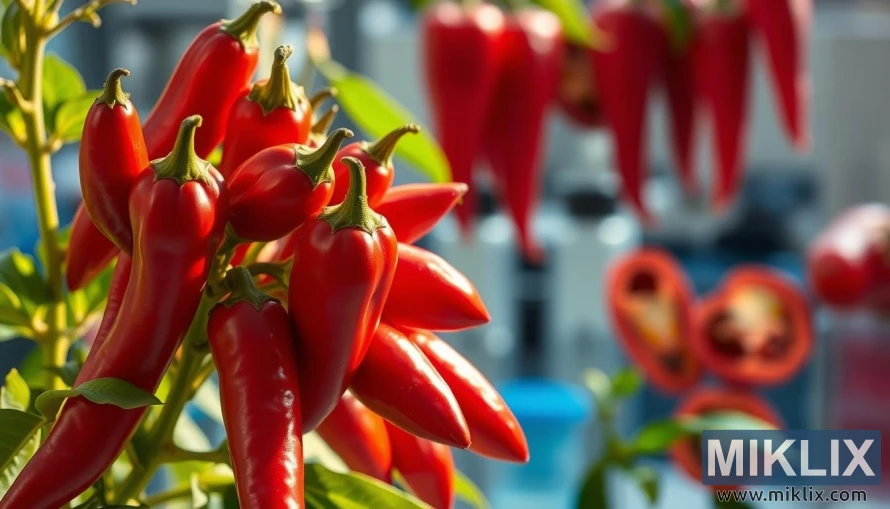Image: Chili Peppers and Research
Published: March 26, 2025 at 6:30:32 PM UTC
Last updated: September 23, 2025 at 9:29:25 PM UTC
High-resolution red chili peppers, whole and sliced, set against a blurred lab backdrop, symbolizing culinary value and potential cancer research benefits.
In this striking image, a cluster of vibrant red chili peppers takes center stage, their elongated forms cascading down from a lush green stem. The peppers gleam under the embrace of warm, natural sunlight, their glossy skins shimmering with an intensity that conveys both vitality and potency. Each pepper, plump and full of character, seems to radiate an energy that goes beyond its culinary reputation, hinting at hidden depths of medicinal promise. The close-up focus reveals the peppers’ rich, saturated hues, ranging from fiery scarlet to deep crimson, while their smooth yet faintly dimpled textures create a tactile allure that makes them appear almost within reach.
As the eye moves to the middle ground, the scene broadens to reveal additional peppers suspended gracefully in the soft blur of the background. Some have been sliced open, their interiors exposed to reveal intricate networks of pale seeds nestled within the bright red flesh. This anatomical glimpse underscores the dual identity of chili peppers: not only as ingredients celebrated for their fiery kick in cuisines across the world, but also as sources of bioactive compounds now attracting the attention of modern science. The seeds, glistening like tiny pearls, stand as quiet reminders of both reproduction in nature and the dense concentration of phytochemicals that lie at the heart of their medicinal potential.
Behind this vivid display, the faint outline of a laboratory comes into view, blurred yet unmistakable in its clinical precision. Glassware, equipment, and workbenches emerge as ghostly shapes, their presence suggesting an environment where the mysteries of these humble peppers are being carefully unraveled. The juxtaposition between the natural brilliance of the peppers and the sterile, methodical world of scientific inquiry highlights a profound harmony between tradition and modernity. The peppers, long valued in folk medicine and culinary practice, are now under the gaze of microscopes and research instruments, their fiery essence distilled into data that may unlock breakthroughs in cancer research and metabolic health.
The overall atmosphere of the composition is one of optimism and discovery. The warm glow that envelops the peppers gives the image a hopeful quality, as though the sunlight itself is symbolic of illumination—casting light not just on the fruits but on the possibilities they represent. The blurred laboratory backdrop becomes more than a setting; it transforms into a metaphor for the bridge between nature’s gifts and humanity’s quest for cures. Here, the peppers are not only symbols of spice and heat but of resilience and healing potential, their bold colors echoing the vibrancy of life itself.
The scene also invites a sensory association that is difficult to ignore. One can almost feel the tingling heat that these chilies would unleash on the palate, the sharp intensity that spreads warmth through the body and awakens the senses. This fiery quality, embodied by capsaicin—the compound responsible for their heat—is precisely what has made them subjects of scientific curiosity. Researchers continue to study capsaicin for its possible role in reducing inflammation, promoting metabolism, and even hindering the proliferation of cancerous cells. Thus, the very sensation that makes chili peppers irresistible in kitchens worldwide also carries within it a promise of deeper therapeutic benefit.
The interplay of natural abundance and scientific exploration in this image captures more than just visual beauty; it conveys a story of transition. What begins as a humble plant rooted in soil evolves into a subject of cutting-edge biomedical research, connecting the wisdom of ancient practices with the rigor of modern laboratories. The composition whispers of balance—between nourishment and medicine, between tradition and progress, between the fiery unpredictability of nature and the structured methodology of science.
Ultimately, this image stands as a visual testament to the chili pepper’s remarkable journey. It celebrates the fruit’s radiant beauty and culinary vibrancy while simultaneously positioning it within the realm of potential medical innovation. Through the glow of sunlight and the blurred backdrop of scientific instruments, it conveys a message of hope—that within these fiery red pods may lie solutions to some of humanity’s greatest health challenges. The peppers seem to embody both the heat of life and the cool precision of science, reminding us that the answers we seek often lie hidden within the natural world, waiting for the right blend of curiosity and inquiry to bring them to light.
The image is related to: Spice Up Your Life: How Chili Boosts Your Body and Brain

